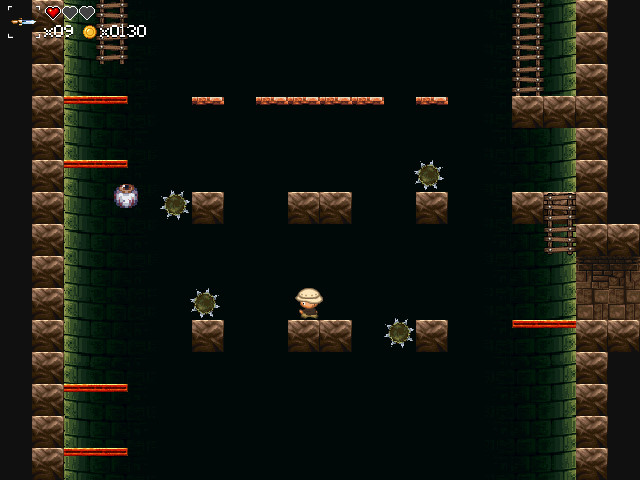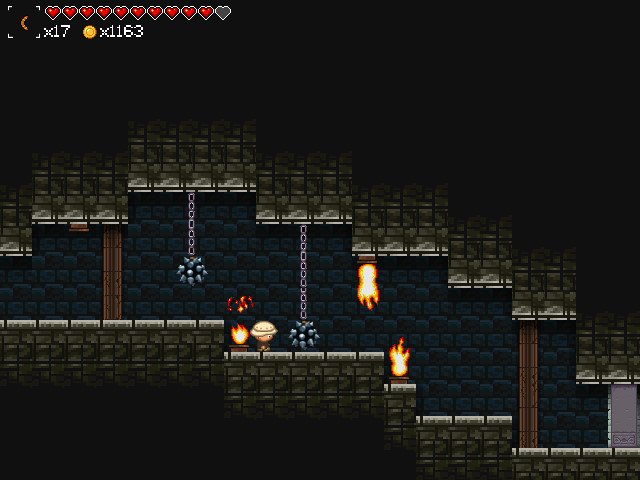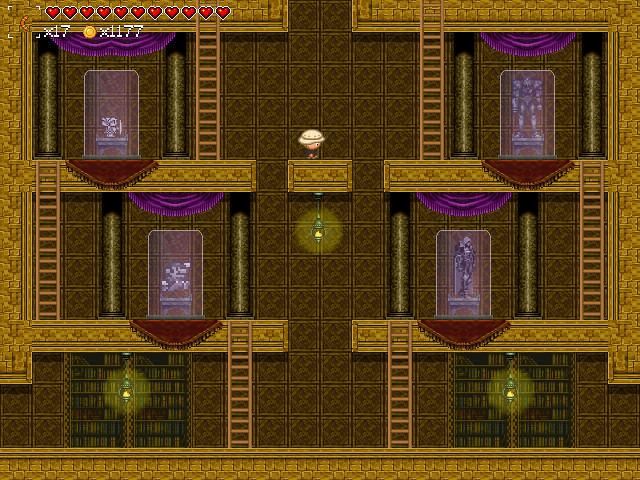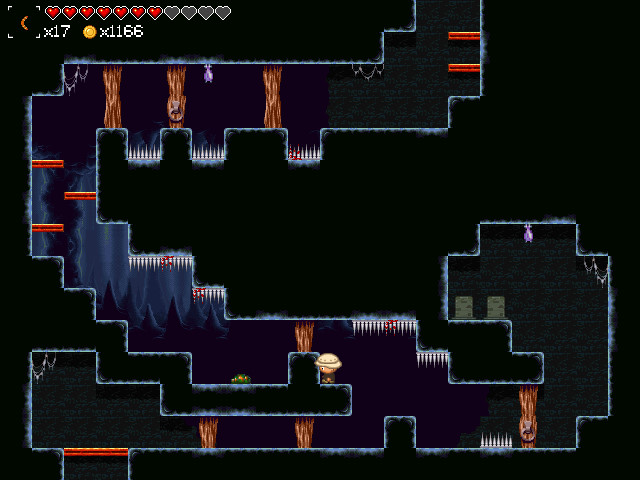Project Adventure Game is a rather challenging Metroidvania which pays tribute to the nostalgic games of the past as well as to the Game Maker engine itself. It has some rough spots and the difficulty level is more of a ‘U’ than a curve, but it also has an interesting, often methodical feel to its progression and gameplay.
The sight of any of the default Game Maker assets in a game usually serves as a giant warning sign that the product is either someone’s first attempt at a game or an unpolished mess with little to no effort put into it. However, in Project Adventure Game the developer, domenec, has decided to use their lack of artistic skill to their advantage by making the game explicitly about this nameless, default explorer who has been used in countless games. Likewise, all (or nearly all) of the assets here are from other games, particularly the Castlevania series, but the game doesn’t come across as inconsistent for two reasons. First, the game blatantly acknowledges that its existence is founded upon other games by featuring a museum where you can store collectibles and statues related to other games and there are plenty of other subtle and not-so-subtle references scattered throughout, one of which even ends up being a plot point in what little story this game has. Secondly, the assets are clearly chosen with care as they almost always fit together so well that it’s virtually impossible to tell that they come from different sources and the few exceptions which stand out tend to do so for the sake of referencing another game. If you ever wanted a lesson in how to make use of preexisting resources in a game then this game serves as a perfect example because the assets fit together well and their usage plays into strengthening the overall tone of the game.

As far as the gameplay is concerned, ‘methodical’ is definitely the key word here. The default movement speed is somewhat slow and the upgrade which allows the protagonist to run is found near the end of the game. The starting jump is also barely more than a hop and the primary weapon is a sword with a fast yet exceedingly close-range slash. Thankfully, your character does become a bit more capable of adventure soon enough with a jump height upgrade and consumable subweapons, though you still need to watch out for fall damage if you jump around aimlessly and ammo for your subweapons is both weapon-specific when it drops and on the uncommon side of things so the sword never becomes entirely obsolete. Between the short range on the sword, the fairly slow movement speed, and the presence of fall damage, precision plays a large role here and it is often important to carefully look at everything in a new room to figure out how to properly navigate the hazards before moving forward.

The way health upgrades and save points are distributed is largely responsible for the strange difficulty curve and the methodical pacing, possibly even more so than the combat and movement. With the exception of a few instant-kill traps, everything in Project Adventure Game deals a single point of damage, but you only start with three hearts so every point of health counts. The first boss is also the only boss in the game which doesn’t have a save point directly next to it and you don’t even have a weapon until you find the sword in the room beyond the boss room (the boss itself appears on the way back). Thus, at the very start of the game you must travel from the first save point to the boss without a weapon and only three hearts, defeat the boss and thankfully get a health refill, and then make your way back to the initial save point – it’s a fairly short journey, but it’s one which is filled with crumbling platforms and deviously positioned bats and the boss itself is far from being a pushover so this is a rather rough welcome and most players are almost certainly going to need to retry it a few times. Things also don’t become much easier once you get a sword because the second region of the game is filled with much more dangerous enemies and plenty of traps and hazards, including instant-kill crushers. This second region also only has one save point at the start and another near the end next to the second boss; there is a warp room, but the room itself is at the end of a somewhat challenging corridor and you still only have three hearts for this entire second region. Though it is often brutal and unforgiving, this second region is rather satisfying to go through as it contains a shield, the jump height upgrade, the first subweapon (daggers), and even a map and the trek back to the closest save point usually lets you make use of your newest acquisition to take shortcuts and/or to more easily deal with the traps and enemies along the way.

For as difficult as the first parts of this game are, the middle chunk of the game is overall much easier, if still a far cry from being easy. The first health upgrade can be found shortly after you acquire the jump upgrade (though the daggers and the shield both make the trek to this upgrade substantially easier) and even this single additional heart allows for significantly more leeway while adventuring. Furthermore, additional health upgrades can be found soon after the first one and, with every enemy and hazard still only ever hitting for one point of damage, the game as a whole becomes substantially easier once your maximum health reaches five or six, let alone more. Alongside this substantial boost to your maximum health, the region layouts after the second one tend to make it easier to reach save points and future warp rooms are located in important locations rather than at the end of otherwise pointless corridors. The difficulty does shoot back up near the end, but not quite in the same deliberate and methodical way as at the start. By far the worst part of the game is a dark maze area where, upon reaching the end, players must make their way back to the start without taking a single hit from the bats and stealthy, immobile weed-like enemies from Castlevania along the way; it’s certainly challenging, but in a way which is both tedious and frustrating rather than clever and engaging. Thankfully, the maze isn’t too long and the final region of the game provides challenges in the forms of dangerous enemies and a large variety of other hazards, making for a satisfying finale.

Project Adventure Game manages to stand out from the majority of other exploration-focused games with its satisfyingly deliberate pacing, but it does have its share of rough spots. Perhaps the biggest issue here is that this game tends to allow players to go through several rooms in a path before placing an obstacle in their way which they might not currently be able to bypass; exploration is great, but if the only rewards in a location require the player to have a specific upgrade in order to reach them then any obstacles which may block progress should be placed at an early point in the path, not near the end. Subweapon ammo is also simply far too difficult to obtain as it can only be found by destroying tombstone-like rocks after acquiring a certain upgrade and even then each subweapon has its own set of ammo. This lack of ammo is especially noticeable because enemies only ever drop money, but money itself is only ever used to play songs on a jukebox even though a shop for ammo refills would have been a perfect addition to the game. It is also not immediately obvious that pressing up and the jump button when near the surface while in water allows players to jump to their full height; this technique is mentioned in the manual which is included with the game download, but I wish it was hinted at within the game itself as it lead to me wasting about an hour frantically backtracking through the map on my first playthrough before I decided to check the manual for potential hints. As to smaller issues, lowering the volume seems to result in certain sound effects permanently remaining quiet even after setting the volume back to normal and there doesn’t seem to be any way to delete saved games if you want to open up a slot other than by physically deleting the save data within the folder itself.

Though it has its share of issues and a difficulty curve which results in the middle portion of the game being the easiest stretch, I greatly enjoyed my time with Project Adventure Game. The unusual pacing and the overall high and often unforgiving, yet rarely unfair, difficulty combine to make for an adventure where every bit of progress feels like a satisfying accomplishment as each room provides a memorable and carefully crafted challenge along the way.